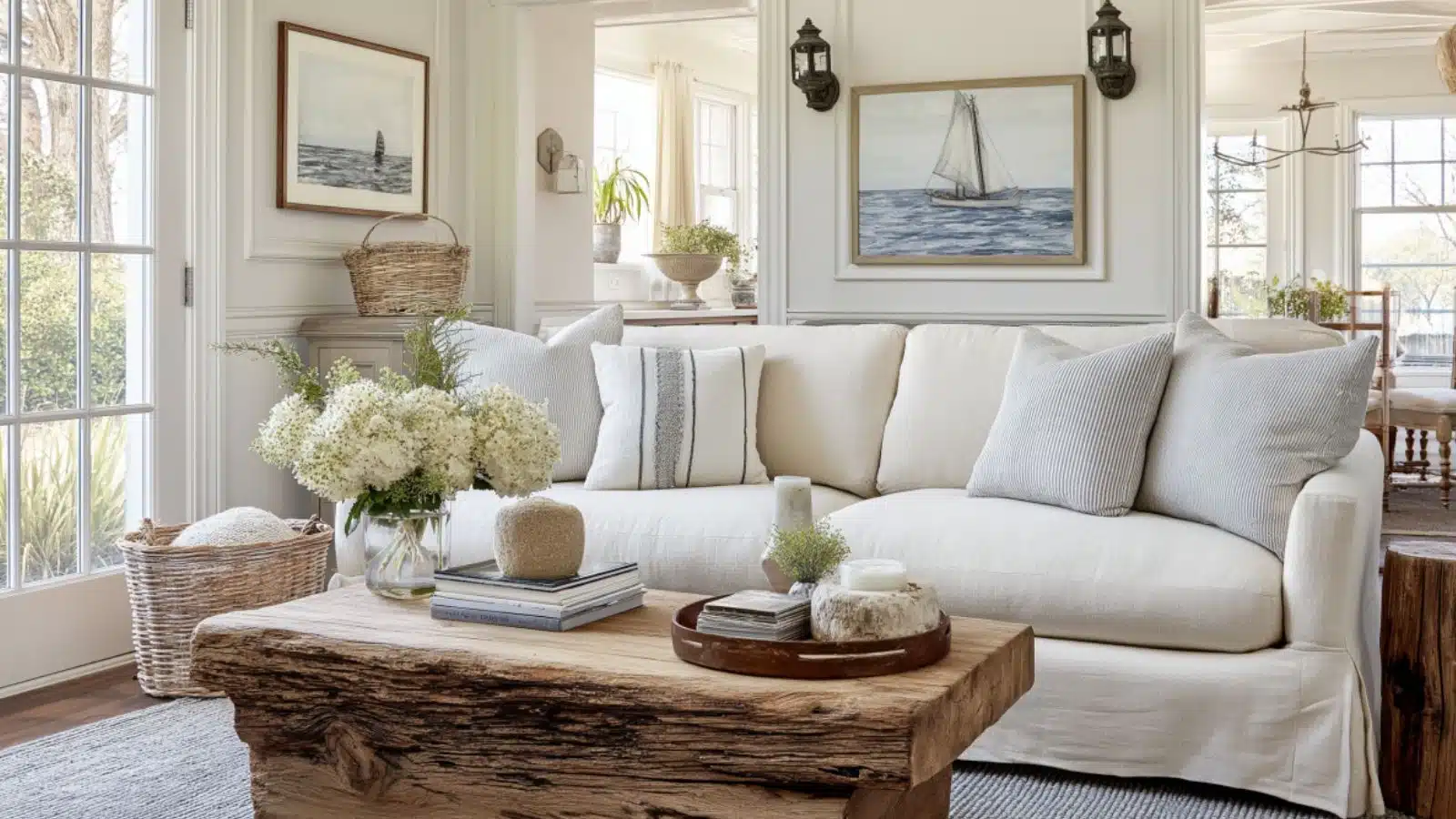Serene Lake House Decor with Neutral Palette and Plants for a Calming Waterfront Retreat
Table of Contents
Have you ever walked into a lake house and instantly felt a sense of serenity? According to a study by the American Psychological Association, exposure to natural elements like water and greenery significantly reduces stress and boosts well-being. For homeowners dreaming of a peaceful getaway, incorporating a neutral palette and abundant plant life creates the perfect backdrop for relaxation.
A serene lake house isn’t just about breathtaking views—it’s also about interior choices that enhance the feeling of calm. A neutral color scheme—think soft whites, beiges, and grays—sets a tranquil tone, while plants bridge the indoors and nature outside. By choosing muted hues and natural textures, you can echo the lake’s quiet beauty throughout your space.
In this article, we’ll walk you through how to decorate a lake house with a serene vibe using a neutral palette and carefully curated greenery. You’ll learn about selecting foundational colors, layering textures, choosing plant placements, incorporating sustainable materials, styling outdoor connections, and balancing comfort with coastal chic. Whether building a new retreat or refreshing an existing cabin, these tips will help you craft a restful, elegant lakefront home.
Choosing the Right Neutral Palette for Your Lake House
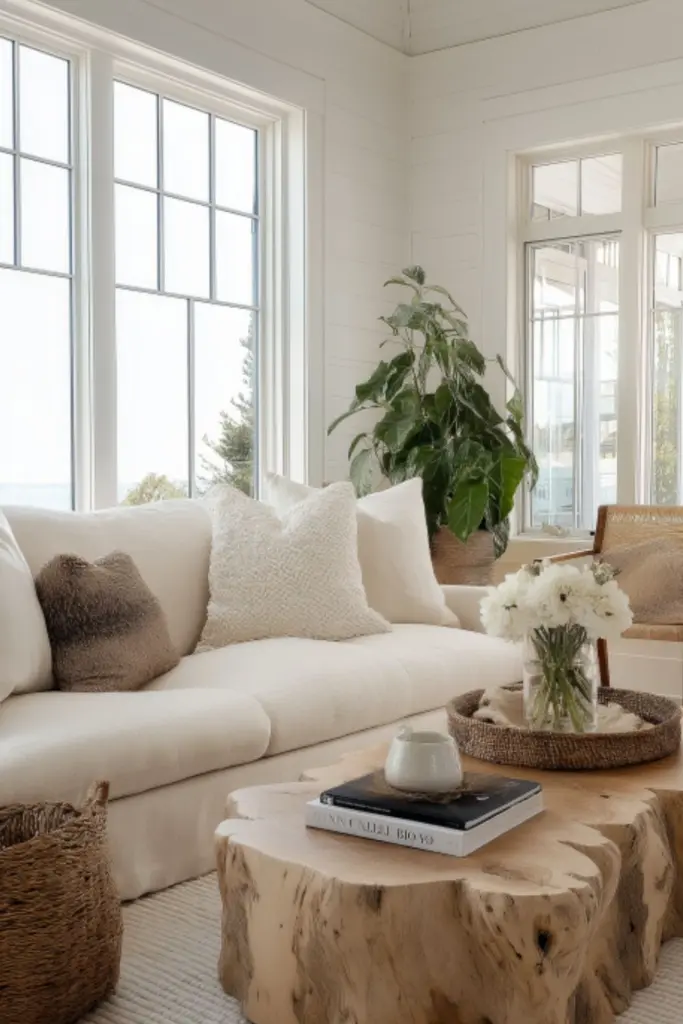
A neutral palette forms the calm canvas on which every design element rests. Soft white walls reflect natural light and mimic the lake’s shimmering surface, while greige or sandy-toned furnishings evoke driftwood tones. Light gray provides a cool, contemporary counterpoint to warm woods.
Ceiling and trim in crisp white create structure without overwhelming the softness. For larger furnishings—sofas, rugs, cabinetry—stick to mid-toned neutrals that are both forgiving and timeless. Introduce depth with accent pieces in charcoal or muted taupe. The end result: an airy, cohesive interior that whispers rather than shouts.
| Surface Area | Suggested Neutral Shade | Why It Works |
|---|---|---|
| Walls/ceilings | Soft white, creamy off-white | Opens space, reflects lake light |
| Floors/rugs | Light gray, beige, driftwood tones | Grounding yet subtle textures |
| Sofas/large furniture | Mid-tone greige or sand | Comfortable without dominating |
| Cabinets/trim | Bright white or warm taupe | Adds structure and contrast |
Layering Natural Textures for Cozy Elegance
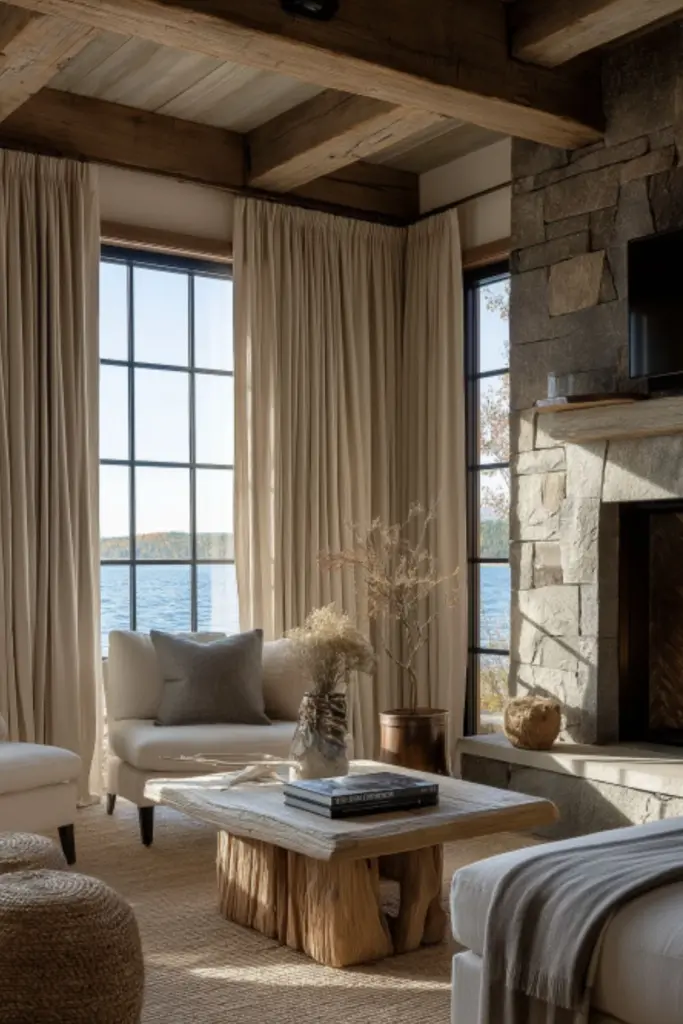
While a neutral palette sets the tone, texture brings warmth and visual interest. In a serene lake house, think natural elements: linen curtains, jute or sisal rugs, reclaimed wood beams, rattan chairs, and stone fireplace surrounds.
Build layers by combining smooth surfaces—like polished hardwood floors—with rougher accents such as driftwood coffee tables or woven baskets. Tactile throws in cotton or wool, stoneware dishes, and woven planter baskets all deepen the sense of comfort while staying grounded in nature.
Your goal is to evoke the feeling of a lakeside retreat through layers—both visual and tactile. These subtle textural shifts enrich the environment without detracting from the restful neutrality.
| Texture Type | Material Examples | Where to Use |
|---|---|---|
| Woven textiles | Jute rug, linen curtains, cotton throws | Floors, window treatments, sofas |
| Wood surfaces | Reclaimed beams, driftwood accents | Beams, coffee tables, shelving |
| Natural stone | Slate fireplace, river rock accents | Fireplace, planter interiors |
| Ceramic and clay | Stoneware plates, clay vases | Dining area, shelves |
Strategic Plant Placement to Enhance Calming Energy
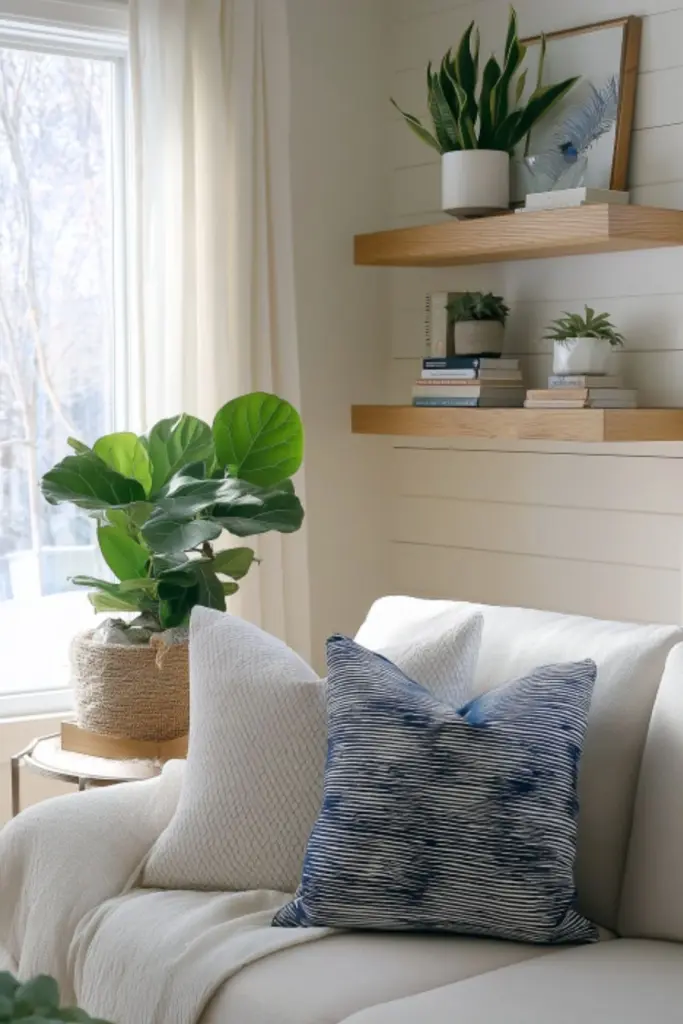
Plants are more than decoration—they’re living elements that improve air quality, mood, and connection to the outdoors. In a serene lake house, the right greenery amplifies the sense of calm.
Start with statement plant placements. A tall fiddle-leaf fig or rubber plant in a woven basket next to a lounge chair draws the eye upward and complements neutral tones. Medium pots of snake plant, ZZ plant, or peace lily in corners add visual anchors. For tabletops or shelves, small succulents or pothos in ceramic pots bring subtle life.
Use trailing plants on bookcases or floating shelves to soften edges. Hanging planters near windows can bring visual interest without sacrificing floor space. Choose hardy species that thrive in indirect light and fluctuating humidity common near water.
It’s not just placement—it’s variety. Combine architectural forms (like the sculptural fiddle leaf) with softer foliage (like ferns or philodendrons) for rhythm and balance.
Plant strategy table
| Plant Type | Ideal Location | Care Level |
|---|---|---|
| Fiddle-leaf fig | Floor next to seating | Medium light, weekly watering |
| Snake plant / ZZ | Entryway or low-light corner | Low light, biweekly watering |
| Pothos / philodendron | Shelves or hanging near windows | Moderate to bright light, watering weekly |
| Succulents | Coffee tables or mantle | Bright light, minimal watering |
Creating Relaxing Social Zones with Seamless Flow
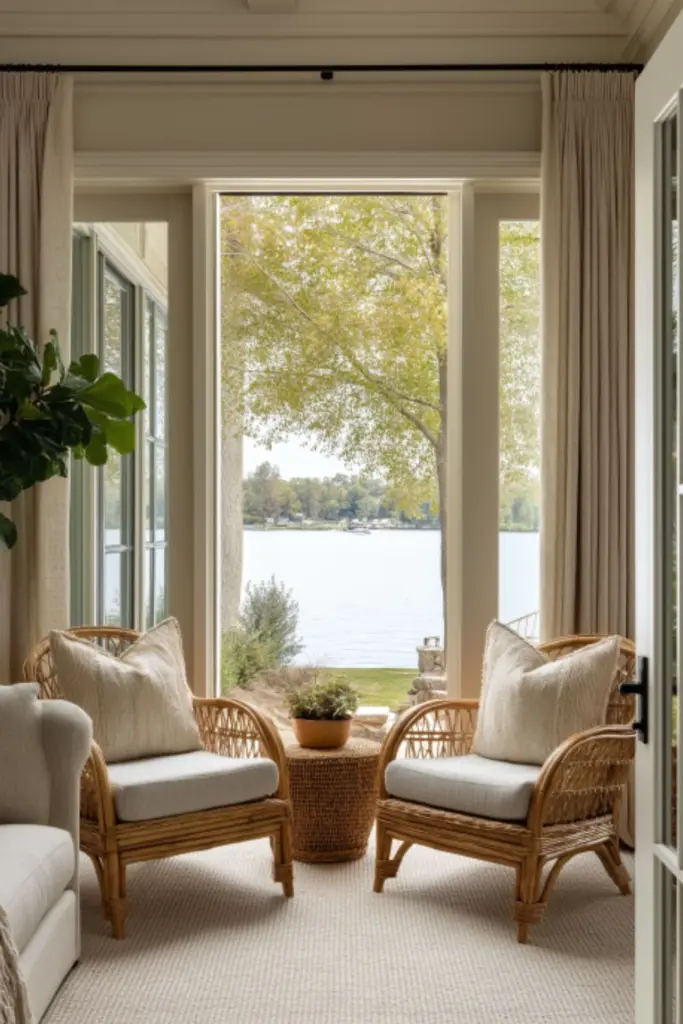
A lake house is best enjoyed with loved ones, so your interior should support conversation, relaxation, and ease. In a neutral palette, furniture placement is key: arrange seating—sofas, lounge chairs—facing each other or oriented toward water views.
Use area rugs to define living, dining, and reading zones. A soft beige or gray rug under the seating section anchors the space without drawing attention. Side tables in wood or rattan add practical balance without clutter.
To maintain openness, choose low-profile furniture and tables that echo natural textures. Keep circulation paths clear, especially near windows or decks where outdoor flow matters. Lighting—floor lamps or pendant lights—should be placed to enhance mood rather than steal focus.
| Zone | Layout Tips | Furniture Style |
|---|---|---|
| Living seating | Arrange for face-to-face interactions | Neutral sofa + rattan lounge chairs |
| Dining area | Centered rug and linear table alignment | Farmhouse wood table with slipcover chairs |
| Reading nook | Cozy corner with plant and side table | Accent chair + ceramic side table |
| Transitional flow | Clear paths to patio or entrance | Round ottoman as functional wayfinder |
Incorporating Sustainable and Natural Materials
Lake houses embody natural beauty, so choosing eco-conscious materials enhances both style and lifespan. Reclaimed wood shelving, bamboo flooring, cork accent panels, organic cotton upholstery, and stone countertops all echo a sustainable philosophy.
Look for low-VOC finishes and responsibly sourced timber to reduce indoor toxins. Bamboo area rugs, wool throws, hemp window treatments, and recycled glass accessories are durable and earth-friendly. Cork is perfect for pin boards or wine racks, while composite decking brings outdoors in, matching interior tones elegantly.
This approach aligns with lake-living: natural, timeless, and low-impact on the surrounding ecosystem.
| Material Choice | Sustainability Benefit | Usage Suggestion |
|---|---|---|
| Reclaimed timber | Reduces waste, unique character | Shelving, beams, accent tables |
| Bamboo/wool textiles | Renewable, biodegradable | Rugs, throws, upholstery |
| Cork or reclaimed glass | Recyclable, resilient | Wall accents, coasters |
| Stone/ceramic | Natural durability | Bathroom sinks/counters, planters |
Connecting Indoors and Outdoors with Transitional Design
A serene lake house flows naturally between interior comfort and outdoor serenity. Transitional design ensures that indoor neutral tones and plant life resonate on your deck, porch, or lakeside patio, creating a cohesive sanctuary.
Extend indoor flooring—like wood-look tile or hardwood—to your outdoor terrace for seamless continuity. Use driftwood benches, wicker lounge furniture, or teak dining sets outside to echo interior materials.
Introduce large potted plants or planters at thresholds to blur lines between inside and out. Outdoor rugs in neutral jute or soft gray anchor seating zones visually. Install string lights or lanterns to extend lakehouse charm into the evening.
Consider architectural features like a pergola or set of feather flags that mirror interior beams or finishes. Visual and material linkages—like matching throw pillows, ceramic pots, or stone boulders—reinforce the connection.
Transition elements table
| Feature | Indoor & Outdoor Link | Design Tip |
|---|---|---|
| Extended flooring | Seamless visual line | Choose moisture-resistant hardwood look tile |
| Matching furniture | Continuity in comfort and color | Use neutral cushions both inside and deck |
| Strategic plants | Life bridging between zones | Use same species or pot styles |
| Lighting continuity | Cohesive ambiance in evening | Lanterns or pendant lights in both areas |
Balancing Function with Aesthetic Simplicity
A serene lake house must be both beautiful and functional, supporting easy living during vacation or everyday use. In a neutral, plant-filled space, organization shouldn’t break the calm.
Use hidden storage ottomans or benches with lift-up tops for games, blankets, or gear. Floating shelves with discreet brackets keep plant pots and books off surfaces. Woven baskets corral blankets, towels, or magazines while adding warmth to shelves.
In the kitchen, display only essential dishware on open shelves. Store extras behind slipcovered cabinets with simple lines. In bathrooms, rolled towels in baskets and neutral containers for soap or toiletries uphold the aesthetic.
| Functional Feature | Utility Benefit | Aesthetic Integration |
|---|---|---|
| Storage ottoman/bench | Holds duvets, games, gear | Neutral woven finish blends in |
| Floating shelves | Keeps counters clear | Mount in wood or white to match palette |
| Woven baskets | Houses linens, toys, or towels | Adds texture without pulling focus |
| Hidden kitchen storage | Durable everyday use | Concealed behind matching cabinet fronts |
Conclusion
Designing a serene lake house decor with a neutral palette and plants is about harmony—blending restful tones, natural textures, and greenery to create a sanctuary by the water. Each element—from the paint on the walls to the choice of materials—should echo the calm of the lake and the beauty of nature all around.
By layering soft neutrals, thoughtful plant placement, sustainable selections, flowing indoor-outdoor transitions, and purposeful storage, your lake house interior becomes a retreat for the senses. It’s a space where the view outside is mirrored in the tranquility inside—a calm, timeless haven made for peaceful moments and lasting memories.

